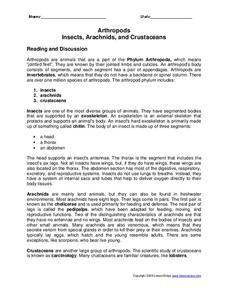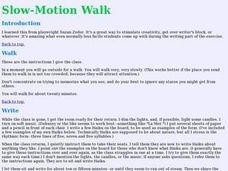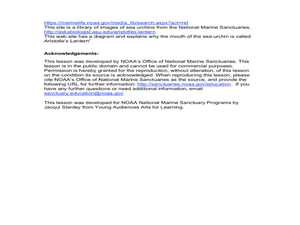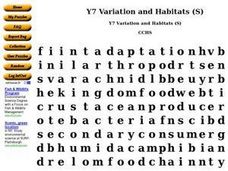Curated OER
The Eyes Have It!
Reading essays about deep-sea expeditions open this instructional activity on crustacean vision. Marine biology explorers study the compound eye and then complete a worksheet in response to all they have discovered. Although the...
Curated OER
Crustacean Critters
Young scholars explore the habitats of hermit crabs. In this crustacean lesson, students discover what animals need to survive. Working with live hermit crabs, young scholars explore how hermit crabs have adapted to their habitats.
Curated OER
Arthropod Coloring
In this arthropod worksheet, students compare and contrast the different animals found in the Phylum Arthropoda: insects, arachnids, and crustaceans. Students complete 8 fill in the blank statements and color illustrations.
Curated OER
Arthropod Rhymes
In this arthropods worksheet, students read rhymes about arthropods and use the science terms they have learned to answer the question following the rhyme. This worksheet has 12 fill in the blank questions.
Curated OER
Ocean Exploration
Students explore a simulated ocean floor. In this environmental lesson plan, students take on roles of an ocean dive team exploring the ocean floor. Dive logs will be created and the students will explore their sections of simulated...
Curated OER
A'ama and Pipipi Adaptations
Students explore ocean creatures. In this crustacean lesson, students determine how Black Nerite snails and Sally Light-foot crabs have adapted to their ocean habitats. Students complete diagrams and hypothesize about the necessity...
Curated OER
Arthropods, Insects, Arachnids, and Crustaceans
In this biology learning exercise, learners read about arthropods and some of the different species that fit into this classification. They then answer 13 questions about what they just learned. The answers are on the last page of the...
Curated OER
Fish Parasite Survey
Students count nematodes, cestodes and crustaceans on approximately one-hundred and fifty fish. They fill out autopsy reports for external and internal parasites then complete and discuss guide questions to make inferences about parasite...
Curated OER
Pill Bug Extravaganza
Tenth graders watch a PowerPoint presentation to review the scientific process. They examine pill bugs before designing an experiment to find new discoveries about these Crustaceans. They complete ten lessons in this unit.
Curated OER
Oceanography: Ocean Market
Sstudents identify consumer goods obtained from the oceans. They classify the items and calculate the cost of buying these goods. After taking a simulated sea shopping spree, they tally the cost of the items purchased. They conclude the...
Curated OER
Building a Pill Bug Palace
Students make "pets" of isopods (potato bugs) to determine their preferred environment and food sources. They record their results on a bar graph and in a scientific report.
Curated OER
Sea Urchins - Diadema Antillarum
Students investigate oceanography by painting sea life. In this crustacean lesson, students identify sea urchins in our ocean environments and describe the functionality of their spherical-shaped bodies. Students design their own sea...
Curated OER
Y7 Variation and Habitats (S)
In this biology instructional activity, students identify and locate various vocabulary terms relating to variations and habitats of living things. There are 37 biology terms located in the word search.
Curated OER
Crustacean Dot To Dot
In this science worksheet, 2nd graders will complete a dot to dot. Students will connect the dots from one to ninety-two to create a common crustacean.















